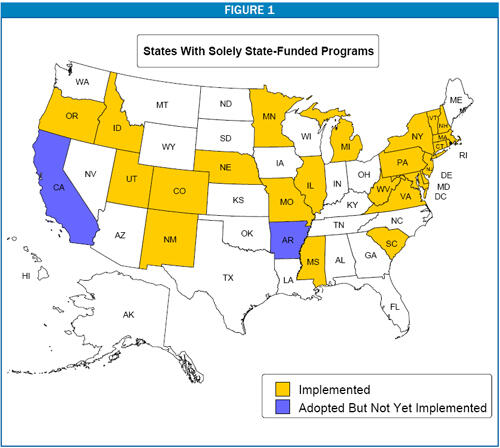- Home
- Designing Solely State-Funded Programs
Designing Solely State-Funded Programs
Implementation Guide for One “Win-Win” Solution for Families and States
Overview
In the wake of federal TANF changes, states face key choices as they decide the next direction for their Temporary Assistance for Needy Families (TANF) programs. In early 2006, Congress enacted changes to TANF in the Deficit Reduction Act (DRA) that effectively increase the proportion of assistance recipients that states must have participating in work activities for a specified number of hours each week. HHS has since issued TANF rules that make it more difficult for states to meet these increased work participation requirements.[1]
States are under pressure to meet these increased work rates and, if they fail to do so, they ultimately could face fiscal penalties. At the same, many states face a tension between initiating or continuing programs that are effective in addressing the range of employability needs of TANF families and creating programs that focus more narrowly on those activities that can count toward federal work rates, even when these “countable” activities are not a good match for some families. Many of the families that are eligible for TANF and that are not able to secure stable employment quickly face serious barriers, ranging from mental and physical health problems and low cognitive functioning to domestic violence, substance abuse, and unstable housing. If these families are to engage in welfare-to-work activities consistently and ultimately move toward employment, more creative and intensive approaches tailored to meet these challenges will be needed.

Similarly, some states make use of education and training programs that do not meet the federal requirements for countable work activities because they exceed the 12 month limitation on vocational educational training. Some of these states had served students in education and training programs exceeding 12 months in MOE-funded separate state programs, which were excluded from the work rate calculation prior to the DRA. States that want to continue these programs risk lowering their work participation rate if they continue to provide assistance to these families in a TANF- or MOE-funded program.
And finally, most states are concerned that under the new structure, they will be unable to meet the 90 percent two-parent work participation rate if they continue to provide aid to two-parent families in TANF- and MOE-funded programs.
One approach many states already have taken and others are considering in response to these challenges is to serve some families — those for whom the federal work participation requirements are inappropriate, overly restrictive, or (in the case of two-parent families) simply too high — outside of the TANF/MOE structure in a separate program that is funded solely with state funds that are not claimed toward the TANF maintenance-of-effort requirement. The state can provide these families with the types of training, education, or rehabilitative activities they need and many could make progress toward future participation in federally countable work activities and employment.
At least half of the states have already implemented “solely-state funded” (or SSF) programs with state funds that will not be reported as MOE. (Appendix)[2] The groups of families served in current SSF programs include two-parent families, families with a parent with a disability, and families with parents attending post-secondary education programs. Specific state examples are discussed throughout this paper.
Establishing a “solely state-funded” program is not the only policy or design approach that a state should consider in its efforts to comply with the federal work requirements and improve the performance of its welfare-to-work programs. It is, however, an approach that can help states meet both of these important goals. It can give states the flexibility they need to tailor their employment-related services to the circumstances of individual recipients, enabling them to continue or initiate evidence-based program approaches rather than simply pursuing strategies that count toward the federal participation rate calculation.
Moreover, while this approach could entail additional state spending — and there are good reasons for states to redirect or add funding to serve needy families — it does not necessarily require that states add money. Without spending additional funding, many states have been able to free up current spending to be used for a solely state-funded program by doing a better job of identifying other current state spending that can be claimed, but is not currently claimed, toward meeting its maintenance-of-effort requirement.
This report provides practical guidance and legal information to state policymakers, human service agency staff, policy analysts, and others on the details of shaping and implementing this approach. The topics covered in greater detail include:
-
Why should a state consider a solely state-funded program
-
How can states finance the solely state-funded program?
-
Which families are good candidates for the state program and what work or rehabilitative activities could a state provide for families?
-
What eligibility policies should a state consider in its program?
-
What are implications of solely state-funded programs on distribution of child support collected by a state?
-
How does receipt of assistance through a solely state-funded program impact eligibility for other programs such as Medicaid, food stamps, child care and any transitional benefits?
-
What administrative mechanisms should a state use to enroll families into a solely state-funded program?
End Notes
[1] 73 Fed. Reg. 6772 et seq. (February 5, 2008).
[2] The states listed in the Appendix may not represent a complete list of all states using or authorizing an SSF. Rather, the table represents information on state initiatives collected by the authors, but this was not a result of a comprehensive all-state survey. As more states adopt solely state-funded programs (or we learn about additional states using this approach), we will update the chart.
More from the Authors

